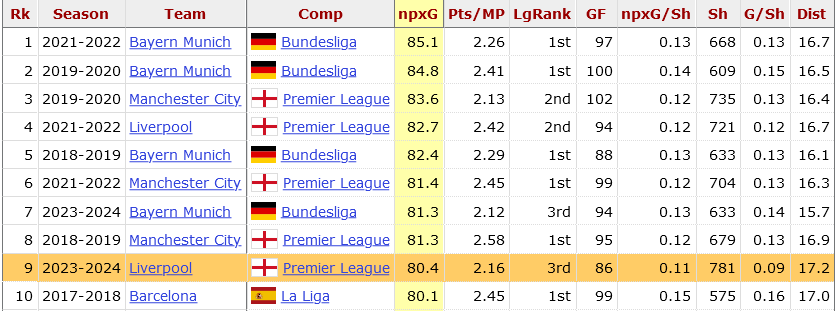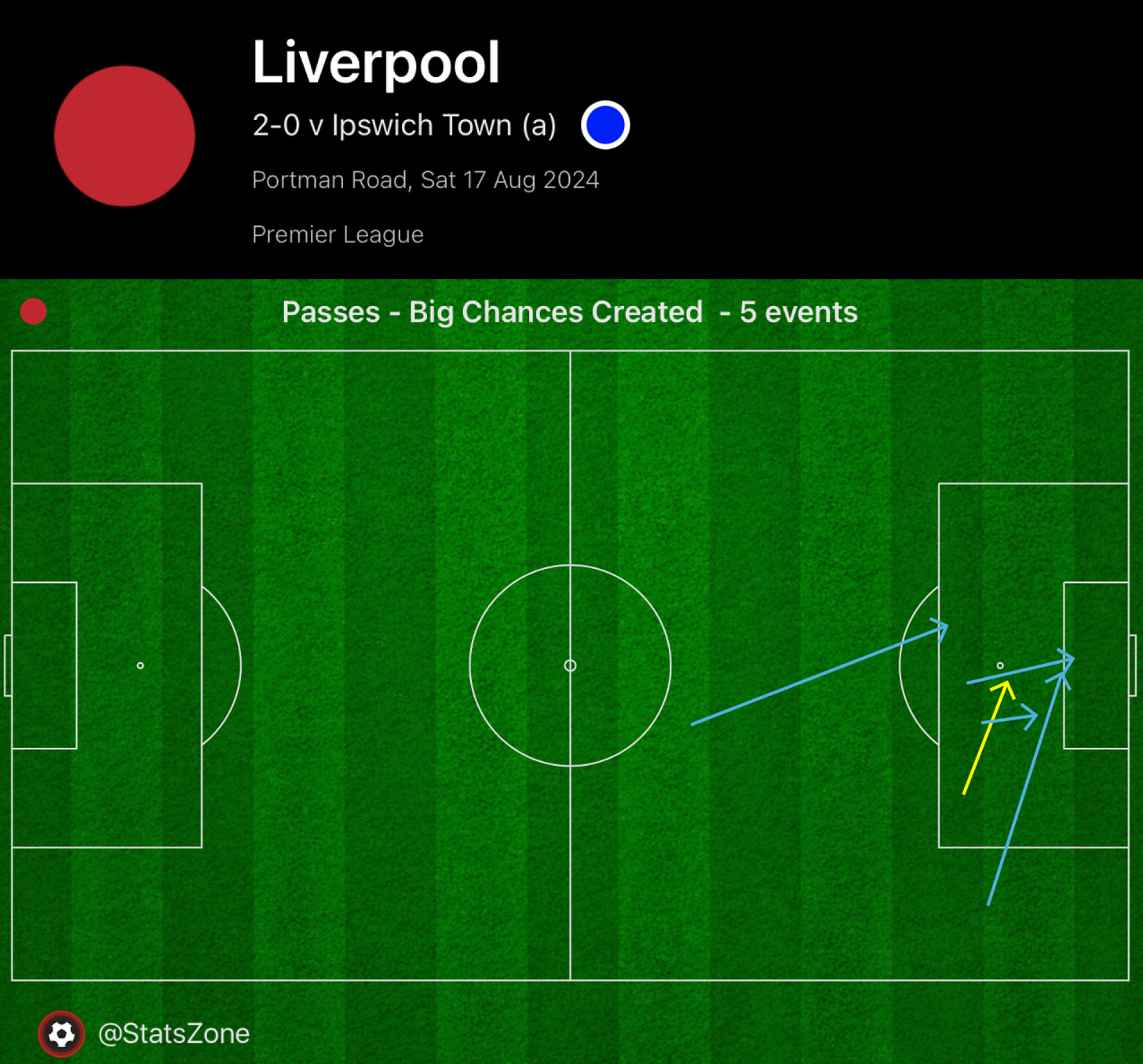Liverpool scored 86 Premier League goals last season, an average of 2.26 per game. The club has won the English title on 19 occasions, with a lower goals per match rate every time.
It says a lot about the dominance of big clubs these days that the only three prior instances of the Reds scoring so often in the top flight occurred in the last decade or so: 2013/14 (2.66), 2018/19 (2.34) and 2021/22 (2.47), a trio of campaigns in which Liverpool finished second.
By taking bronze on the Premier League podium in Jürgen Klopp’s final season, the primary issue must have been in defence, right? There have only been five instances of a Reds team conceding at least as many goals per game (1.08) when finishing in the top two, after all. It had happened just once in the last 60 years.
It is at the back of the team where new boss Arne Slot will find the lowest hanging fruit. He has proven he can restrict opposition shots too. Feyenoord conceded just 7.6 per 90 minutes in the Eredivisie last season, from an average distance of 19.6 yards; of the 96 teams in Europe’s big five leagues, only Atalanta did better on the latter metric, while no side did on the former.
(Hover over any blue dot on the chart on the website to see which team it represents)
We cannot yet say if Slot’s Liverpool will reach Feyenoordian heights on the above chart. However, they have conceded no more than eight shots in four of their last six matches (for which we have to incorporate pre-season). Reaching a broadly similar level doesn’t feel impossible from what we have seen so far, at least, which is a decent place to start.
Tightening up at the back should obviously lead to more clean sheets. With the attacking potential at Slot’s disposal, wins aplenty should naturally follow.
This is not to say gains can’t be made at the front too. The Liverpool class of 2023/24 became one of just 10 sides in England, France, Germany, Italy or Spain to amass at least 80 non-penalty expected goals in the last seven seasons.
They did superbly well to generate so many goal scoring opportunities. But what else do you notice about last seasons Reds on the above table of elite attacking outfits? Liverpool 2023/24 had more shots than any other side, which instinctively feels positive. And it is, but none of the other nine teams were as bad as them for:
Average distance of shot from goal (Dist)
Non-penalty expected goals per shot (npxG/Sh)
Goals per shot (G/Sh)
Goals scored (GF)
That quartet works as a sequence which explains the situation perfectly. If a team is shooting from further out, it’s chance quality will naturally be lower. That makes it harder to convert shots into goals, so don’t be surprised if they - guess what? - score less often. Some teams build their xG by hammering on the door now and again, whereas Klopp’s final Reds side would occasionally spend too long quietly tapping. It’s little wonder they didn’t always get an answer.
Which brings us to Portman Road, some interesting numbers and the Liverpool shot map from the game which you can see at the beginning of the article. After a first half in which the Reds had three shots collectively worth just 0.10 xG (per FBRef), they rallied significantly to record six Opta-defined big chances in one half for the first time in 28 months.
This put the match into around the 90th percentile of Liverpool games for statistically golden opportunities, so it would probably be in the top one per cent across all teams. Even more heartening is that five of the big chances were created, in the sense of one player passing to another, rather than relying upon penalties, rebounds or fortunate deflections. The variety of delivery methods - one cross, one through-ball and three passes from within the penalty area - is a positive too.
It is only one game against a newly promoted side. Liverpool have had plenty of matches against similar outfits without being so wonderfully incisive in the past though. A team which averaged 20.6 non-penalty shots with an average value of 0.11 xG last season recorded figures of 18 and 0.15 here. Less became more, a drop in quantity traded for a extra drop of quality.
If you look for Premier League matches in which the away side hit both of the markers the Reds notched at Ipswich, there aren’t many. Just 36 in the last 2,670 games, in fact.
Looking up instances of home or away team hitting those benchmarks unearths two never-to-be-forgotten Liverpool matches, for good and bad. The Reds had 18 shots of an average 0.15 xG value when beating Manchester United 7-0 at Anfield. However, the same was true of Aston Villa when they thrashed Liverpool 7-2 in the excitement-void that was pandemic-era football. Not every team with these statistics scores seven goals, of course, but it shows what is realistically possible.
The improvements needed in the Reds’ defensive structure have been obvious for a couple of years, with opposing sides often able to create good chances far too easily. The tweaks needed up front are far more subtle. The early evidence is that Slot has implemented both, even if it will take tougher tests and far more matches to prove the point.






Another great article!
Really interesting analysis.. it’s really interesting to read in Graham’s book just how much klopps attacking risk/reward style correlates with the approach suggested by the data modelling..
But I know many of us spent last season watching and just hoping we could tighten up somewhat, become more compact and add a little more control.
It will be really interesting to see what changes slot can make to have a significant impact on these areas..
Ipswich was positive because although we struggled to play out first half, and then went direct, we didn’t leave ourselves particularly stretched and exposed as we regularly did last season.
We still recorded what 18 shots which isn’t far off the 20 we averaged last year.. highest xG in the league IIRC, and I would hazard a guess a closer average shot distance(?), certainly on the big chances!
Big test against the monsters of Brentford this weekend!
Mo’s won a free kick, I’m so excited just had to comment. On the half way line like. Great stuff as ever Andrew